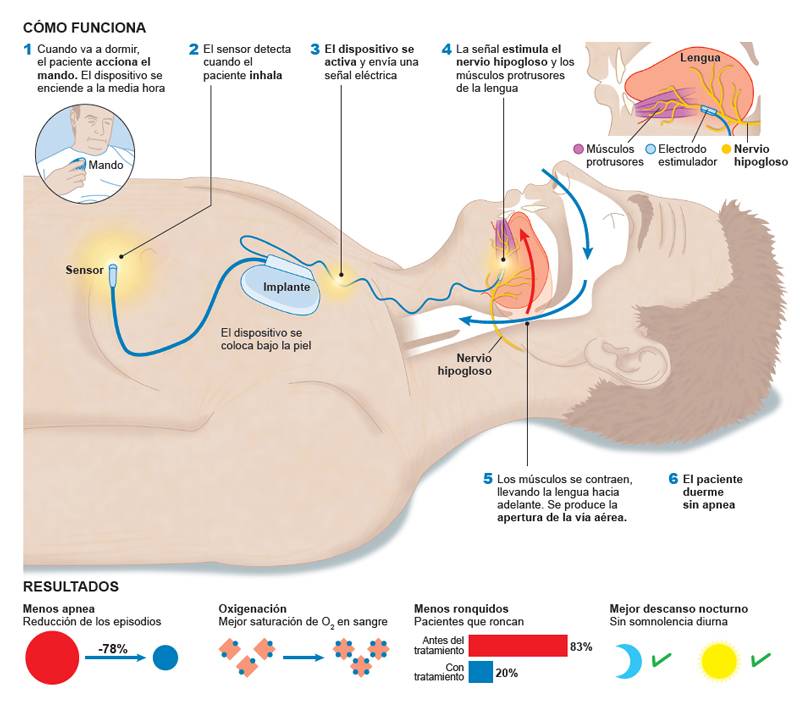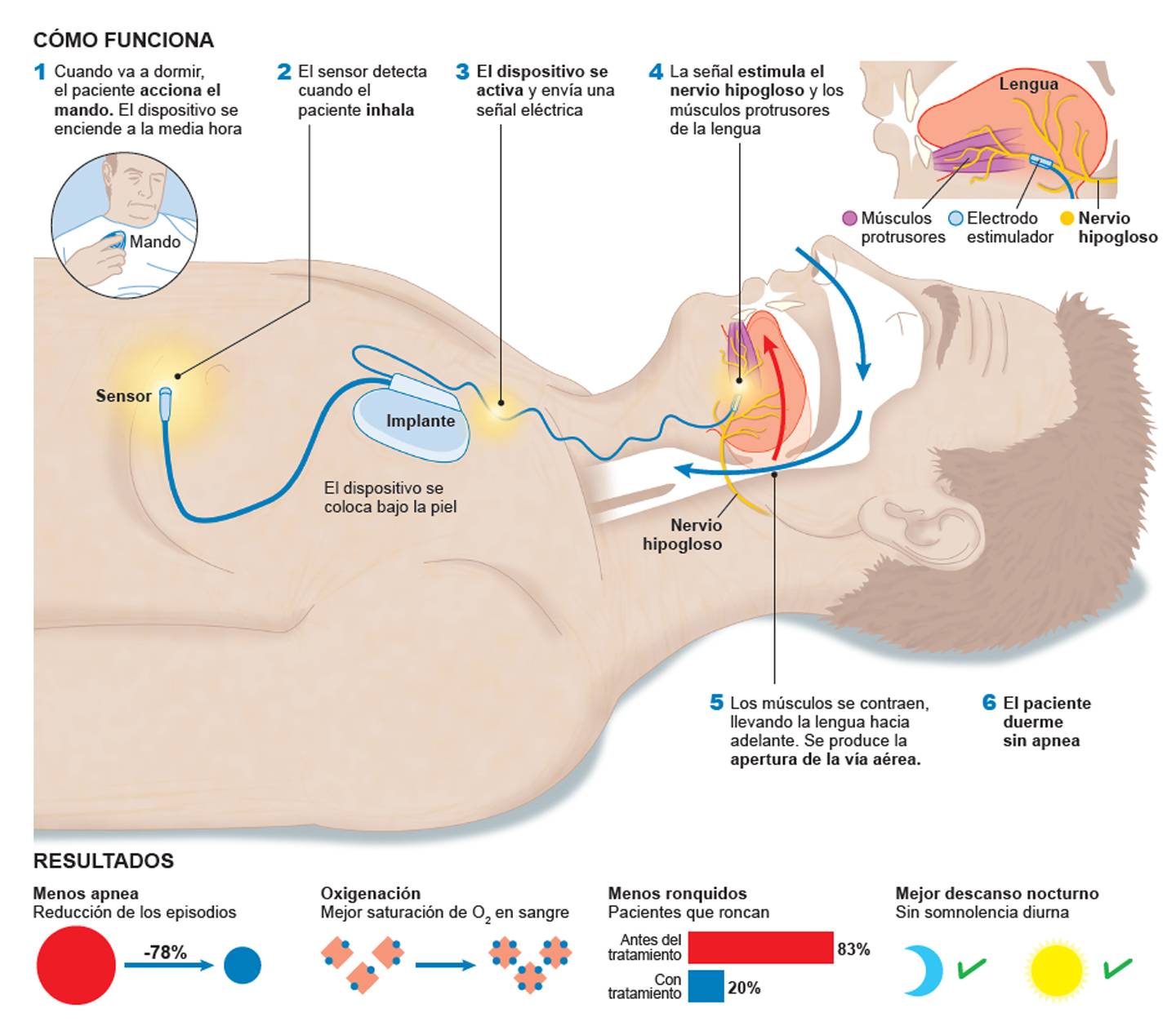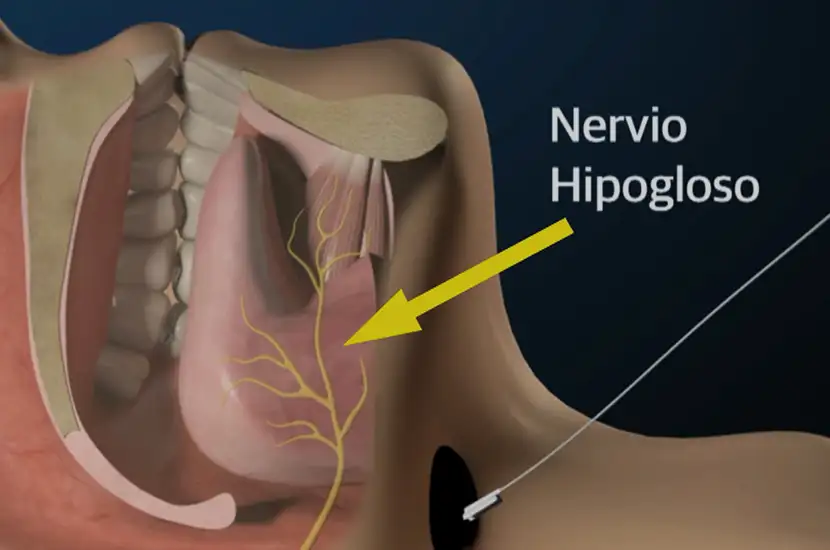Stimulation of the hypoglossal nerve for the treatment of OSAS
"We are the first center in Spain to implant the hypoglossal nerve stimulator and we have more than 30 patients with excellent results".
DR. JORGE DE ABAJO SPECIALIST. OTORHINOLARYNGOLOGY DEPARTMENT

Obstructive sleep apnea is a breathing disorder that is caused by intermittent and repetitive obstruction of the upper airway during sleep. Such blockage results in a complete (apnea) or partial (hypopnea) interruption of airflow. This syndrome affects about 4% of the adult population, according to international epidemiological studies.
The syndrome of apnea of the dream frequently takes place by a collapse of the superior aerial route, often produced by the flaccidity of the weaves or by other causes, like the obesity since, if fat is accumulated in the neck, it tends to exert pressure in the aerial route.
It may also be due to anatomical alterations that the patient may present as large tonsils, very large tongue base or bone alterations.
This new treatment consists of the electrical stimulation of the hypoglossal nerve, the nerve responsible for the movement of the tongue. By stimulating it, it manages to push forward the base of the tongue and the palate of the patient, preventing the blockage of the airway and allowing the entry of air during sleep.
Stimulation therapy of the hypoglossal nerve allows effective treatment, without the need to wear a mask.

When is hypoglossal nerve stimulation indicated?
- Patients undergoing polysomnography or sleep study showing an apnea/hypopnea index below 65 events per hour with few central events, less than 25% per hour.
- Favorable upper airway anatomy. Before HNS is considered, sleep endoscopy is likely to be performed to assess the anatomy and location of the obstruction in the upper airway.
- The patient should have a body mass index of less than 32.
- Intolerance or lack of response to CPAP. CPAP is the first-line treatment for OSA, but some patients cannot tolerate it or do not see improvement with its use.
- No significant comorbidities that contraindicate the procedure or the use of the device.
- Lack of response or intolerance to other treatments. This includes oral devices or surgeries such as uvulopalatopharyngoplasty (UPPP).
- Age appropriateness. Hypoglossal nerve stimulation is generally indicated for adults and is not recommended for children or adolescents.
Do you snore in your sleep and pause for apnea?
You may be able to benefit from stimulation of the hypoglossal nerve
How is hypoglossal nerve stimulation performed?
How does the Genio device work?
During sleep, the muscles of the tongue and pharynx relax. In some patients this muscle relaxation leads to airway collapse and secondarily to obstructive apnea. Stimulation of the hypoglossal nerve seeks to maintain a constant muscle tone that prevents muscle collapse by means of modulated electrical stimulation.
The Genio device allows stimulation of the two nerves through an implantable electronic device placed under the chin, with a small incision that is concealed in one of the skin folds of the neck.
It is activated by means of another external device that communicates wirelessly with the implant by means of disposable stickers that are periodically provided to the patient. Once programmed, the stimulation begins progressively as the patient falls asleep.
The advantages of this system:
- Stimulation of the two nerves.
- Minimal incision in the neck area: no need to place the implant in the chest area, which is aesthetically better tolerated.
- External battery that allows daily recharging without the need of surgery for its replacement.
- Personalized modulation according to the characteristics of each patient.
What is the Inspire device procedure like?
The hypoglossal nerve stimulation procedure to treat sleep apnea is simple and consists of the subcutaneous implantation (under the skin), in the anterior area of the thorax, of a stimulator, similar to a pacemaker, to which a sensor is connected. In turn, the sensor cable is inserted, through another small incision, into the wall of the chest where it detects inspiration. It is then that the sensor sends a signal to the stimulator, from which a discharge is emitted that reaches, through a cable, the hypoglossal nerve.
In this way, the muscles at the base of the tongue and the palate are stimulated forward, opening the airway and facilitating normal breathing.
The patient requires only 24 hours of hospitalization and the intervention lasts approximately 2-3 hours. After one month, the stimulator is activated and the patient is taught how to use it. A check-up is then performed the following month with a sleep study to fully adjust the device.
Once adjusted, the activation of the device is done by the patient himself, every night by means of a control, when going to sleep. After 30 minutes, the device begins to work.
The device works for 8 hours, and if the patient wakes up during the night he or she can put it on pause. The advantage of this equipment is that the intensity can be adjusted according to the patient's needs.
Pioneering technique to solve apnea
We are the only center that has implanted this device in Spain and we have an experience of more than 30 patients with excellent results.
Where do we do it?
IN NAVARRA AND MADRID
The Department of Otolaryngology
of the Clínica Universidad de Navarra
The Department of Otorhinolaryngology of the University of Navarra Clinic is a national and world reference in numerous highly specialized surgical procedures.
We have the latest technology and we perform all diagnostic tests in less than 48 hours in order to offer our patients the best solution in the shortest time possible.
We were one of the first centers in Spain to use robotic surgery in the surgical treatment with the Da Vinci® System.
Organized in specialized units:
- Otology - Hearing.
- Rhinology - Nose.
- Pharyngology - Throat.
- Laryngology - Voice.
- Balance disorders.
- Head and neck problems.

Why at the Clinica?
- Experts in the treatment of hearing problems.
- Pioneers in axillary surgery to avoid scarring.
- National reference center in tissue sealing for tonsil removal.
















